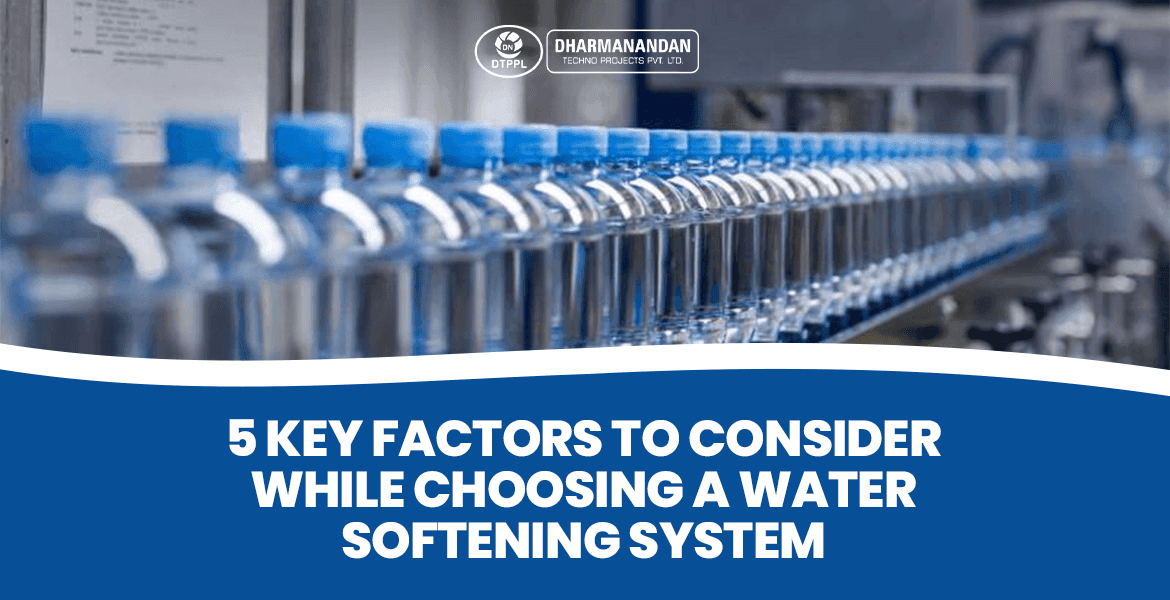
Table of Contents
5 Key Factors to Consider While Choosing a Water Softening System
June 25, 2024Water softening system are designed to address the issues caused by hard water, which contains high levels of minerals such as calcium and magnesium. These minerals can accumulate in pipes and appliances, leading to scale buildup, reduced efficiency, and potentially costly repairs. Hard water can also affect household chores, making it more difficult to get soap to lather and leaving spots on dishes and glassware.
A water softening system works by removing or neutralizing these minerals, transforming hard water into soft water. This process typically involves ion exchange, where calcium and magnesium ions are replaced with sodium or potassium ions. The result is water that is kinder to plumbing, appliances, and even skin and hair.
Water Hardness Levels
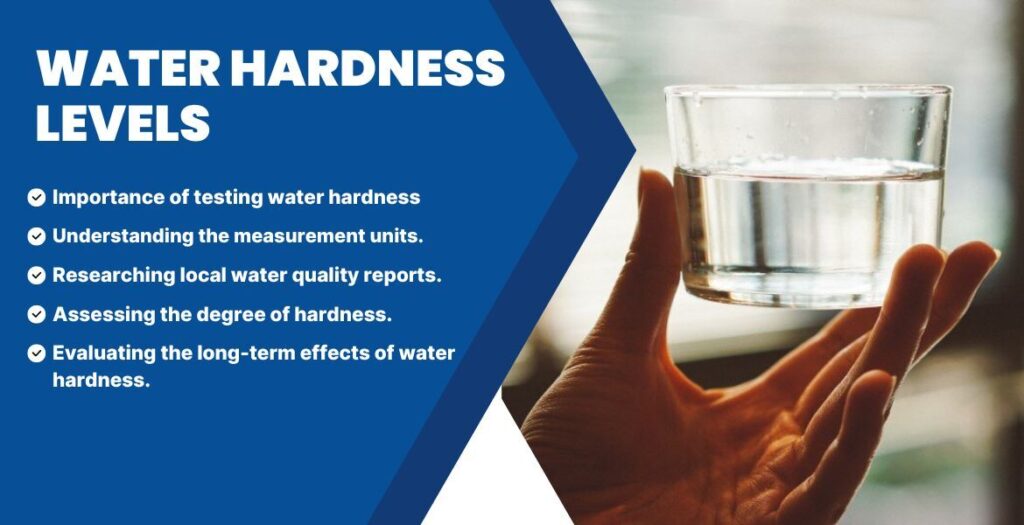
Water hardness refers to the concentration of calcium and magnesium ions in water. These minerals are naturally present in groundwater and absorbed from surrounding soil and rock. The level of hardness in your water can significantly impact both your household and your health, making it crucial to understand and manage it effectively.
Importance of testing water hardness levels using appropriate methods and equipment
Testing your water hardness levels is the first step in determining the need for a water softening system. Accurate testing ensures that you can choose the right system and avoid over- or under-softening your water. Common methods for testing water hardness include:
- Test strips: Easy to use and provide quick results. Simply dip the strip into a water sample and compare the color change to a chart.
- Titration kits: These kits involve adding a chemical reagent to a water sample until a color change indicates the hardness level. They offer more precise results than test strips.
- Electronic water testers: These devices measure water hardness by detecting electrical conductivity, and providing accurate digital readings.
Understanding the measurement units
Water hardness is typically measured in grains per gallon (mpg) or milligrams per liter (mg/L) of calcium carbonate (CaCO3). Here’s a general classification of water hardness:
- Soft: 0-3.5 gpg (0-60 mg/L)
- Moderately hard: 3.5-7 gpg (60-120 mg/L)
- Hard: 7-10.5 gpg (120-180 mg/L)
- Very hard: 10.5+ gpg (180+ mg/L)
Researching local water quality reports
Local water quality reports, often available from your municipality or water supplier, provide valuable information about the water hardness in your area. These reports are typically updated annually and can be found online or by contacting your local water authority. By reviewing these reports, you can gain insights into the average hardness levels of your water supply and determine if additional testing is necessary.
Assessing the degree of hardness
Assessing the degree of hardness involves comparing your test results to standard hardness levels. This assessment helps you understand the severity of your water’s hardness and the potential impact on your household. For instance, if your water falls into the “hard” or “very hard” categories, it may lead to scale buildup in pipes and appliances, as well as reduced efficiency and lifespan of water-using appliances.
Evaluating the long-term effects of water hardness
The long-term effects of hard water can be significant and costly. Scale buildup in pipes can lead to reduced water flow and increased energy consumption as appliances work harder to function efficiently. Over time, this can result in higher utility bills and expensive repairs or replacements of appliances like water heaters, dishwashers, and washing machines.
By understanding water hardness levels and their implications, you can make informed decisions about the need for a water softening system and choose the most suitable solution for your home. This proactive approach will help you protect your household infrastructure, improve the quality of your water, and enhance your overall quality of life.
Type of Water Softener
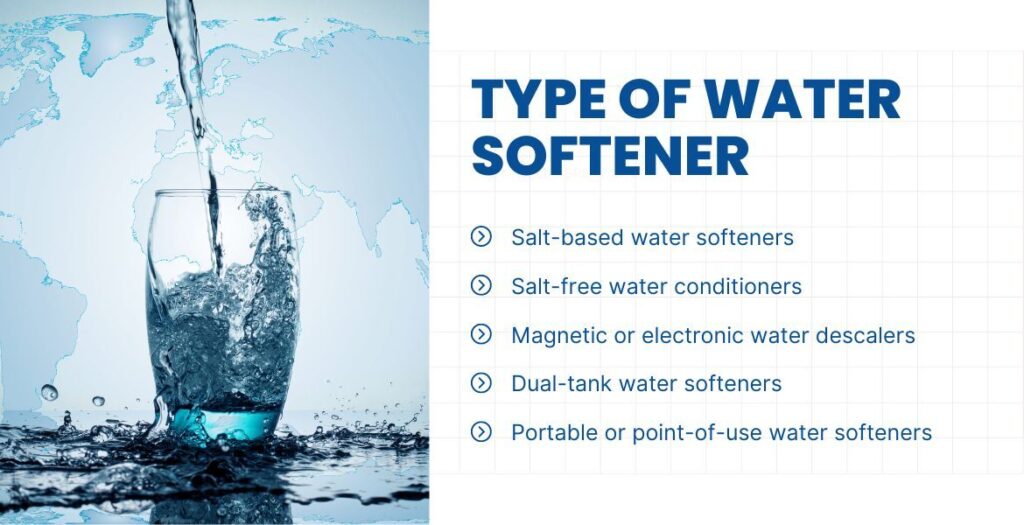
Let’s dive into the different types of water softeners:
- Salt-based water softeners:
- These are the most common types of water softeners. They use ion exchange to remove hardness minerals (calcium and magnesium) from water.
- The system contains a resin tank filled with tiny resin beads. When hard water passes through, the resin beads attract and trap the calcium and magnesium ions, replacing them with sodium ions.
- Salt-free water conditioners:
- Unlike salt-based softeners, these systems do not remove minerals from water. Instead, they condition the minerals to prevent scale buildup.
- They use a template-assisted crystallization (TAC) process. The conditioner alters the structure of hardness minerals, making them less likely to adhere to surfaces.
- Magnetic or electronic water descalers:
- These devices claim to soften water by using magnetic or electronic fields.
- However, scientific evidence supporting their effectiveness is limited. Some users report positive results, while others remain skeptical.
- Dual-tank water softeners:
- These advanced systems have two resin tanks. While one tank is in service, the other regenerates.
- Suitable for larger households or commercial settings.
- Portable or point-of-use water softeners:
- Designed for specific faucets or appliances (e.g., showerheads, coffee makers).
- Compact and easy to install.
Remember to choose a water softener based on your specific needs, water hardness, and available space. Regular maintenance ensures optimal performance!
Regeneration Method
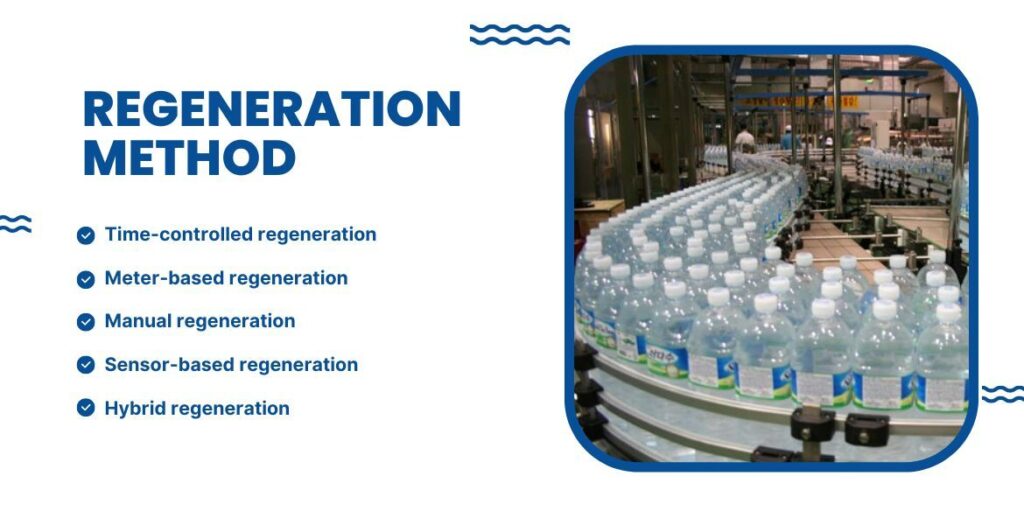
The regeneration method of a water softener refers to how the system recharges its resin bed to continue softening water effectively. This process is essential for maintaining the softening capacity of the system over time. There are several regeneration methods commonly used in water softeners:
Time-controlled regeneration
In time-controlled regeneration, the softener regenerates based on a preset schedule, regardless of how much water has been used. This method is simple and easy to set up but may lead to unnecessary regeneration cycles, resulting in wasted salt and water.
Meter-based regeneration
Meter-based regeneration, also known as demand-initiated regeneration, regenerates the softener based on water usage. This method is more efficient than time-based regeneration, as it reduces salt and water waste.
Manual regeneration
Some water softeners require manual initiation of the regeneration process. This typically involves turning a valve or pressing a button to start regeneration. Manual regeneration gives users more control over when the system regenerates but requires regular monitoring and attention.
Sensor-based regeneration
Sensor-based regeneration uses sensors to monitor the condition of the resin bed and trigger regeneration when it is needed. This method is efficient and ensures that regeneration occurs only when necessary, reducing salt and water waste.
Hybrid regeneration
Some water softeners combine multiple regeneration methods to optimize efficiency and performance. For example, a system may use meter-based regeneration as the primary method but switch to time-based regeneration if water usage patterns are inconsistent.
Choosing the right regeneration method depends on your household’s water usage patterns, preferences for automation, and desire for efficiency and control. Consider factors such as convenience, efficiency, and maintenance requirements when selecting a water softener with a specific regeneration method.
Maintenance Requirements of Water Softeners
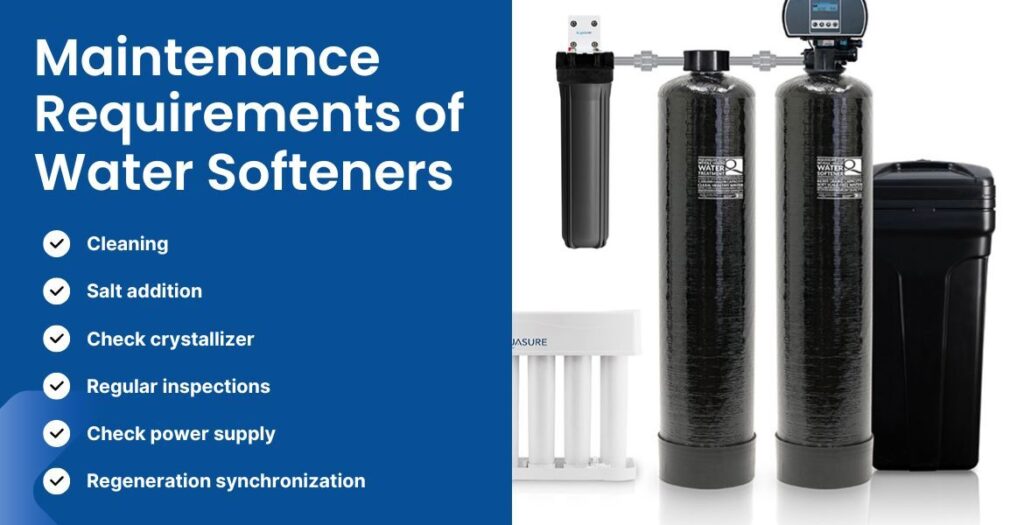
Maintaining your water softening system is essential to ensure its continued performance and longevity. Proper maintenance helps prevent issues such as scale buildup, resin bed fouling, and system malfunction. Here are some key maintenance tasks for different types of water softeners:
Salt-based water softeners
- Salt addition: Regularly check the salt level in the brine tank and add salt as needed. Keep the tank at least one-quarter full to ensure proper regeneration.
- Cleaning the brine tank: Periodically clean the brine tank to remove any accumulated dirt, debris, or salt bridges that may impede the salt dissolving process.
Salt-free water conditioners
- Check crystallizer: For TAC systems, check the crystallizer periodically to ensure it is functioning correctly and not clogged with scale.
- Maintenance-free: Salt-free systems generally require less maintenance than salt-based systems, but it’s still important to monitor performance and water quality regularly.
Magnetic or electronic water descalers
- Check power supply: Ensure the power supply to the descaler is uninterrupted. Check for any loose connections or damage to the unit.
- Monitor performance: Regularly monitor the water quality to ensure the descaler is effectively preventing scale buildup.
Dual-tank water softeners
- Check both tanks: Periodically check both resin tanks for salt levels, cleanliness, and any signs of damage or malfunction.
- Regeneration synchronization: Ensure that both tanks are regenerating in sync to maintain a continuous supply of soft water.
Portable or point-of-use water softeners
- Regeneration: Follow the manufacturer’s instructions for regenerating the unit, which may involve flushing with a salt solution.
- Cleaning: Clean the unit regularly to prevent clogs and maintain optimal performance.
General maintenance tips for all water softeners
- Regular inspections: Periodically inspect your water softener for leaks, clogs, or other signs of wear and tear.
- Professional servicing: Consider having your water softener serviced by a professional annually to ensure it is functioning correctly and efficiently.
By following these maintenance guidelines, you can ensure that your water softening system continues to provide you with soft, quality water for years to come. Regular maintenance not only extends the life of your system but also ensures that it operates efficiently, saving you money on energy and maintenance costs.
Conclusion
Choosing a water softening system is an important decision that can significantly impact your household’s water quality and overall comfort. By understanding the key factors in selecting a water softener, you can make an informed choice that meets your needs and preferences.
First, understanding your water hardness levels and testing methods is crucial for determining the right system for your home. This involves researching local water quality reports, assessing the degree of hardness, and evaluating the long-term effects of hard water on your household.
Next, consider your water usage and demand to ensure the chosen water softening system can meet your household’s needs. Whether you opt for a salt-based, salt-free, magnetic, dual-tank, or portable water softener, each type has its advantages and maintenance requirements.
Finally, maintaining your water softener ensures its efficiency and longevity. Regular maintenance tasks such as checking salt levels, cleaning the brine tank, and monitoring system performance are essential for optimal operation.

Director – Global Marketing and Sales
Mr. Bhavesh from Dharmanandan Techno Projects Pvt. Ltd. has played a pivotal role in elevating the DTPPL brand to the global stage, leveraging his exceptional expertise in marketing and communications. He is committed to helping clients achieve significant growth while strengthening their own brands. Dharmanandan Techno Projects Pvt. Ltd. is a leading manufacturer and supplier of water purification systems and turnkey solutions for mineral water plants. With years of experience in designing and delivering high-quality water treatment solutions, the company provides end-to-end services, including system design, installation, maintenance, and ongoing support. Specializing in scalable and customizable water plants, DTPPL has successfully served industries worldwide, ensuring clean and safe drinking water across diverse applications.
